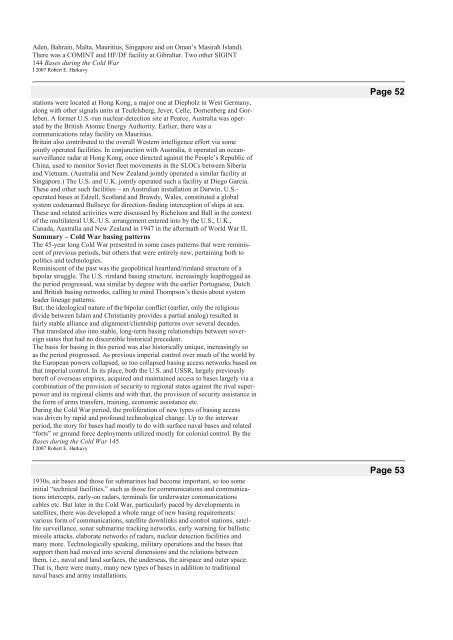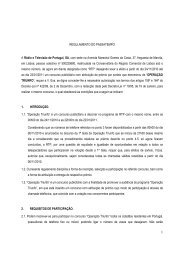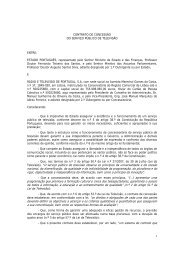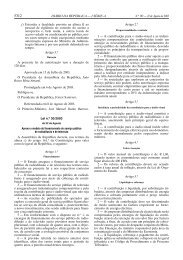squadron at Hong Kong, as <strong>the</strong> latter’s reversion to China loomed. In Belize, alingering point of tension in connection with Guatemalan irredentist aims, <strong>the</strong>supporting British force included four Harriers and also four Puma and fourGazelle helicopters. Gibraltar still saw occasional deployments of Jaguar fighteraircraft. In <strong>the</strong> Falklands <strong>the</strong>mselves, <strong>the</strong> U.K. – to deter ano<strong>the</strong>r invasion whichcould have seen an enhanced Argentinian air assault – maintained on station afull squadron of nine Phantoms and Harrier vertical take-off and landing(VTOL) aircraft, Hercules tactical transports and several Sea King and Chinookhelicopter detachments. This was almost, quixotically, <strong>the</strong> largest RAF presenceoutside of Europe. Overall, <strong>the</strong> RAF had some 17,000 personnel stationedabroad.The U.K. also deployed some ASW aircraft at overseas bases, supplementing<strong>the</strong> near-global presence of <strong>the</strong> large U.S. force of P-3C Orions. The Britishequivalent was <strong>the</strong> nuclear-capable Nimrod MR2 aircraft. These were periodicallydeployed at Wideawake Airfield on Ascension; Kindley Naval Air Station,Bermuda; Akrotiri, Cyprus; Stanley Airfield in <strong>the</strong> Falklands; Gibraltar;Keflavik, Iceland; Sigonella, Sicily and perhaps also Konya Air Base, Turkey.The French Air Force, again in direct association with army detachments,maintained a fairly significant presence in several African states. These forceshad been directly engaged in some local wars where, even in small numbers,<strong>Bases</strong> <strong>during</strong> <strong>the</strong> <strong>Cold</strong> <strong>War</strong> 143İ 2007 Robert E. Harkavy<strong>the</strong>y could be decisive or at least telling because of an absence of counterweights,at least so long as Soviet or Cuban pilots were not directly engaged. Atminimum, <strong>the</strong>y acted as tripwire deterrents – for several Francophone regimes –against local aggression or external involvement.The main points of deployment were in Djibouti, <strong>the</strong> Central African Republic,Chad, Gabon, <strong>the</strong> Ivory Coast and Senegal. Jaguar fighter-bombers (codevelopedwith <strong>the</strong> U.K.) were deployed in <strong>the</strong> Central African Republic, Chadand Gabon; Mirage F-1C aircraft were also deployed to Chad. Djibouti had asquadron of ten Mirage IIIs. Alouette and Puma helicopter were stationed in allof <strong>the</strong>se countries, in <strong>the</strong> Ivory Coast <strong>the</strong>y constituted <strong>the</strong> only French Air Forcepresence. There were C-160 Noratlas transport aircraft deployed to <strong>the</strong> CentralAfrican Republic, Chad, Djibouti, Gabon and Senegal. In <strong>the</strong> latter case, Francehad based at Dakar and also at Djibouti Breguet Atlantique maritimesurveillanceaircraft in areas not far from frequent Soviet naval deployments inWest Africa and <strong>the</strong> Indian Ocean. The Noratlases provided for speedy movementof French or o<strong>the</strong>r surrogate forces in case of crisis or conflict.Aircraft based in Chad were earlier military engaged, as were those based inSenegal, which flew missions on behalf of Mauritania and Morocco earlier on<strong>during</strong> <strong>the</strong> Western Sahara war. Outside of Africa, France had no permanentlystationed combat aircraft, though helicopters and utility aircraft were deployedin Martinique, Guadeloupe, French Polynesia, Reunion and <strong>the</strong> MozambiqueChannel Islands.O<strong>the</strong>rwise, one can point merely to a few scattered external deployments ofaircraft represented by still o<strong>the</strong>r members of <strong>the</strong> Western alliance. The Ne<strong>the</strong>rlandshad deployed some P-3Cs through Keflavik, Iceland and through Britishair bases at St. Mawgan and Machrihanish. Australia had kept two squadrons ofMirages in Malaysia as its contribution to <strong>the</strong> defense of Sou<strong>the</strong>ast Asia. NewZealand up to 1982 had also had a small air presence in Singapore.Concerning technical facilities, <strong>the</strong> U.K., which deployed SSBNs and SSNsin <strong>the</strong> eastern Atlantic, had LF transmitters at Bermuda and Gibraltar; <strong>the</strong> latterwas capable of reaching across <strong>the</strong> Mediterranean to <strong>the</strong> Indian Ocean (until1976 <strong>the</strong> U.K. had naval communications facilities at Mauritius and Singapore,when it also still maintained a naval presence east of Suez). It had ano<strong>the</strong>r atPort Stanley in <strong>the</strong> Falklands, which would obviously have been of value in caseof resumption of hostilities in that area. It also deployed an RAF/UKADGEearly-warning radar at Sornfelli in <strong>the</strong> Danish-controlled Faeroe Islands.Britain also fielded some additional, scattered C3I assets overseas. It had amajor SIGINT site on Cyprus at Pergamos/Dhekelia. Elsewhere, on Cyprus, <strong>the</strong>U.K. had a troposcatter communications relay, a Skynet satellite-communicationsterminal and an OTH radar in <strong>the</strong> Troodos Mountains capable of monitoringmissile tests within <strong>the</strong> USSR. There were reported Government CommunicationsHeadquarters (GCHQ) SIGINT stations on Ascension (Two Boats) and St.Helena islands; also at Darwin, Australia (earlier, <strong>the</strong>re were o<strong>the</strong>rs in Botswana,Page 51
Aden, Bahrain, Malta, Mauritius, Singapore and on Oman’s Masirah Island).There was a COMINT and HF/DF facility at Gibraltar. Two o<strong>the</strong>r SIGINT144 <strong>Bases</strong> <strong>during</strong> <strong>the</strong> <strong>Cold</strong> <strong>War</strong>İ 2007 Robert E. Harkavystations were located at Hong Kong, a major one at Diepholz in West Germany,along with o<strong>the</strong>r signals units at Teufelsberg, Jever, Celle, Dornenberg and Gorleben.A former U.S.-run nuclear-detection site at Pearce, Australia was operatedby <strong>the</strong> British Atomic Energy Authority. Earlier, <strong>the</strong>re was acommunications relay facility on Mauritius.Britain also contributed to <strong>the</strong> overall Western intelligence effort via somejointly operated facilities. In conjunction with Australia, it operated an oceansurveillanceradar at Hong Kong, once directed against <strong>the</strong> People’s Republic ofChina, used to monitor Soviet fleet movements in <strong>the</strong> SLOCs between Siberiaand Vietnam. (Australia and New Zealand jointly operated a similar facility atSingapore.) The U.S. and U.K. jointly operated such a facility at Diego Garcia.These and o<strong>the</strong>r such facilities – an Australian installation at Darwin, U.S.-operated bases at Edzell, Scotland and Brawdy, Wales, constituted a globalsystem codenamed Bullseye for direction-finding interception of ships at sea.These and related activities were discussed by Richelson and Ball in <strong>the</strong> contextof <strong>the</strong> multilateral U.K./U.S. arrangement entered into by <strong>the</strong> U.S., U.K.,Canada, Australia and New Zealand in 1947 in <strong>the</strong> aftermath of World <strong>War</strong> II.Summary – <strong>Cold</strong> <strong>War</strong> basing patternsThe 45-year long <strong>Cold</strong> <strong>War</strong> presented in some cases patterns that were reminiscentof previous periods, but o<strong>the</strong>rs that were entirely new, pertaining both topolitics and technologies.Reminiscent of <strong>the</strong> past was <strong>the</strong> geopolitical heartland/rimland structure of abipolar struggle. The U.S. rimland basing structure, increasingly leapfrogged as<strong>the</strong> period progressed, was similar by degree with <strong>the</strong> earlier Portuguese, Dutchand British basing networks, calling to mind Thompson’s <strong>the</strong>sis about systemleader lineage patterns.But, <strong>the</strong> ideological nature of <strong>the</strong> bipolar conflict (earlier, only <strong>the</strong> religiousdivide between Islam and Christianity provides a partial analog) resulted infairly stable alliance and alignment/clientship patterns over several decades.That translated also into stable, long-term basing relationships between sovereignstates that had no discernible historical precedent.The basis for basing in this period was also historically unique, increasingly soas <strong>the</strong> period progressed. As previous imperial control over much of <strong>the</strong> world by<strong>the</strong> European powers collapsed, so too collapsed basing access networks based onthat imperial control. In its place, both <strong>the</strong> U.S. and USSR, largely previouslybereft of overseas empires, acquired and maintained access to bases largely via acombination of <strong>the</strong> provision of security to regional states against <strong>the</strong> rival superpowerand its regional clients and with that, <strong>the</strong> provision of security assistance in<strong>the</strong> form of arms transfers, training, economic assistance etc.During <strong>the</strong> <strong>Cold</strong> <strong>War</strong> period, <strong>the</strong> proliferation of new types of basing accesswas driven by rapid and profound technological change. Up to <strong>the</strong> interwarperiod, <strong>the</strong> story for bases had mostly to do with surface naval bases and related“forts” or ground force deployments utilized mostly for colonial control. By <strong>the</strong><strong>Bases</strong> <strong>during</strong> <strong>the</strong> <strong>Cold</strong> <strong>War</strong> 145İ 2007 Robert E. Harkavy1930s, air bases and those for submarines had become important, so too someinitial “technical facilities,” such as those for communications and communicationsintercepts, early-on radars, terminals for underwater communicationscables etc. But later in <strong>the</strong> <strong>Cold</strong> <strong>War</strong>, particularly paced by developments insatellites, <strong>the</strong>re was developed a whole range of new basing requirements:various form of communications, satellite downlinks and control stations, satellitesurveillance, sonar submarine tracking networks, early warning for ballisticmissile attacks, elaborate networks of radars, nuclear detection facilities andmany more. Technologically speaking, military operations and <strong>the</strong> bases thatsupport <strong>the</strong>m had moved into several dimensions and <strong>the</strong> relations between<strong>the</strong>m, i.e., naval and land surfaces, <strong>the</strong> underseas, <strong>the</strong> airspace and outer space.That is, <strong>the</strong>re were many, many new types of bases in addition to traditionalnaval bases and army installations.Page 52Page 53
- Page 2 and 3: This provided the U.S. access to a
- Page 4 and 5: ecame a hot issue within Japan, and
- Page 6 and 7: SpainRotaMajor naval base; also air
- Page 8 and 9: eturn to the link here with aircraf
- Page 10 and 11: which were in Fairbanks (Alaska), T
- Page 13: Molesworth), Belgium (Florennes), t
- Page 17 and 18: III,” 14 stations giving flexible
- Page 19 and 20: wire retaliation strike plan. The n
- Page 21 and 22: Ocean surface surveillance47The U.S
- Page 23 and 24: each site, providing variable cover
- Page 25 and 26: Pinetree LineCanadaBroughton Island
- Page 27 and 28: that is, the Limited Test Ban Treat
- Page 29 and 30: Missile Crisis.68At another level,
- Page 31 and 32: Access for Soviet surface ships.Per
- Page 33 and 34: nel in Libya, whose air force compr
- Page 35 and 36: systems (an exception, of course wa
- Page 37: Madagascar). There was also a signi
















